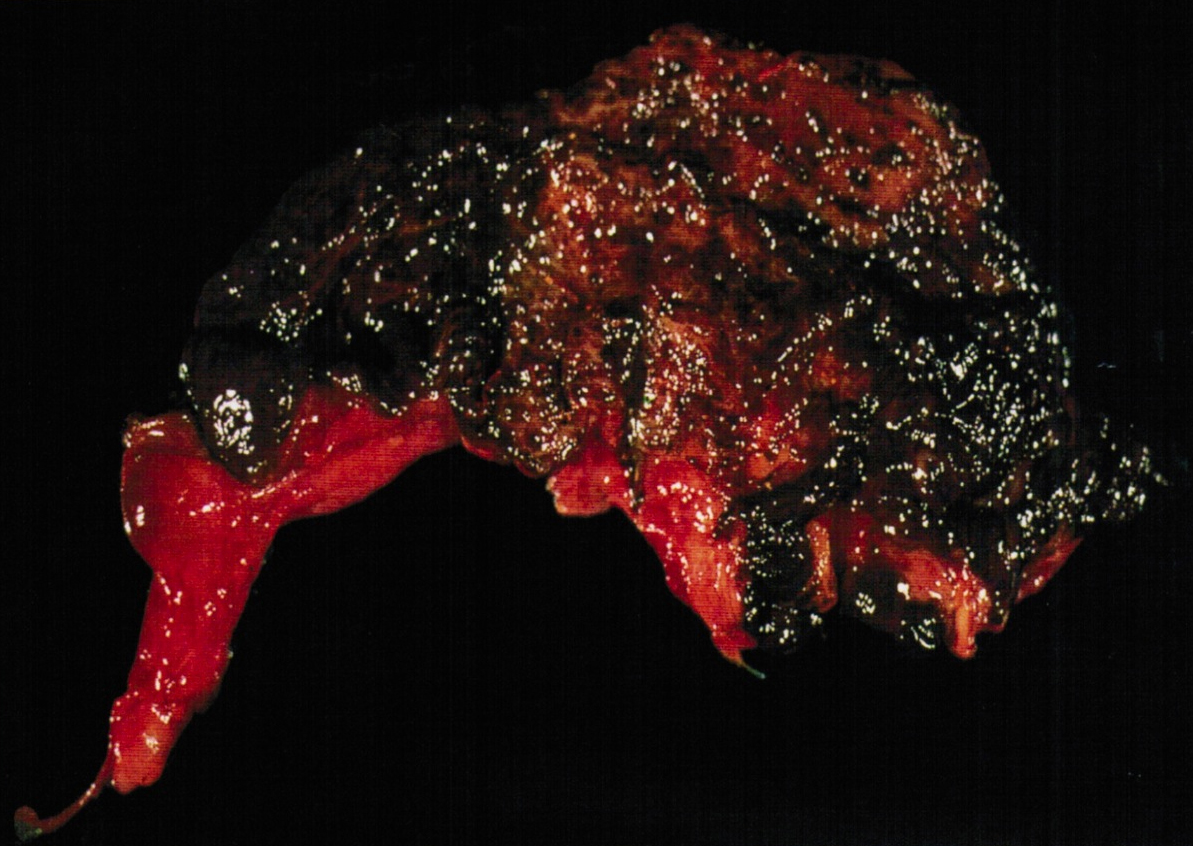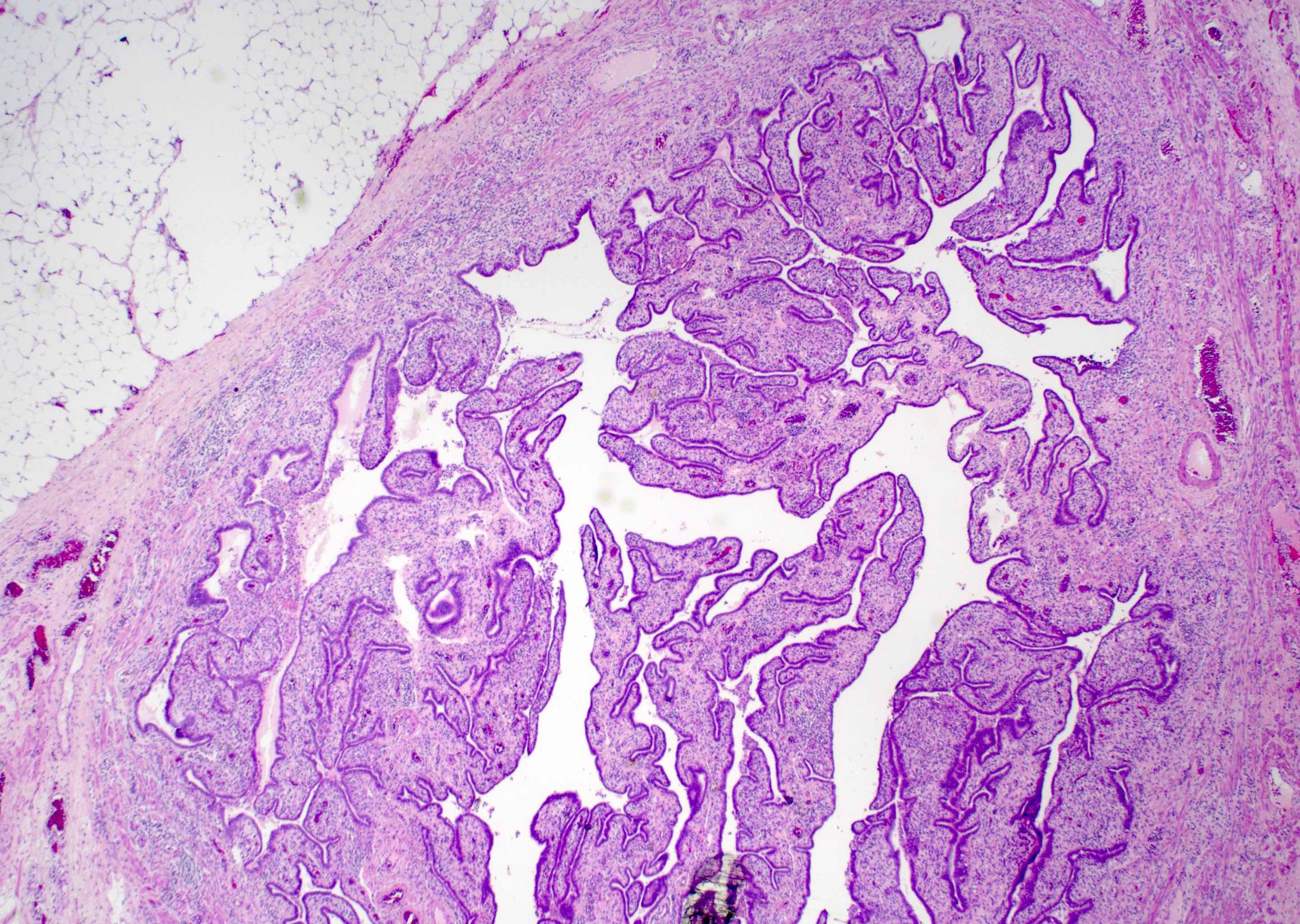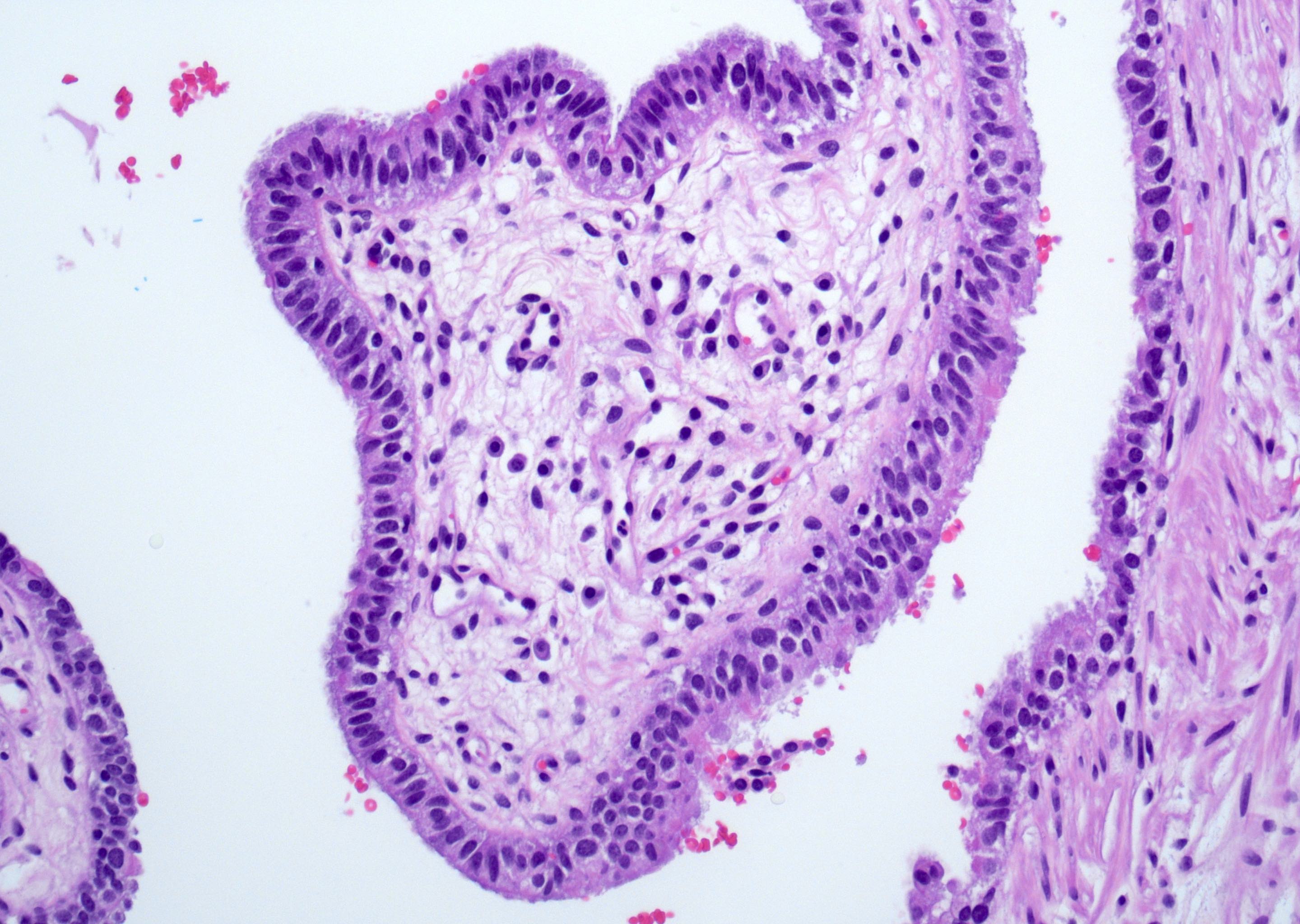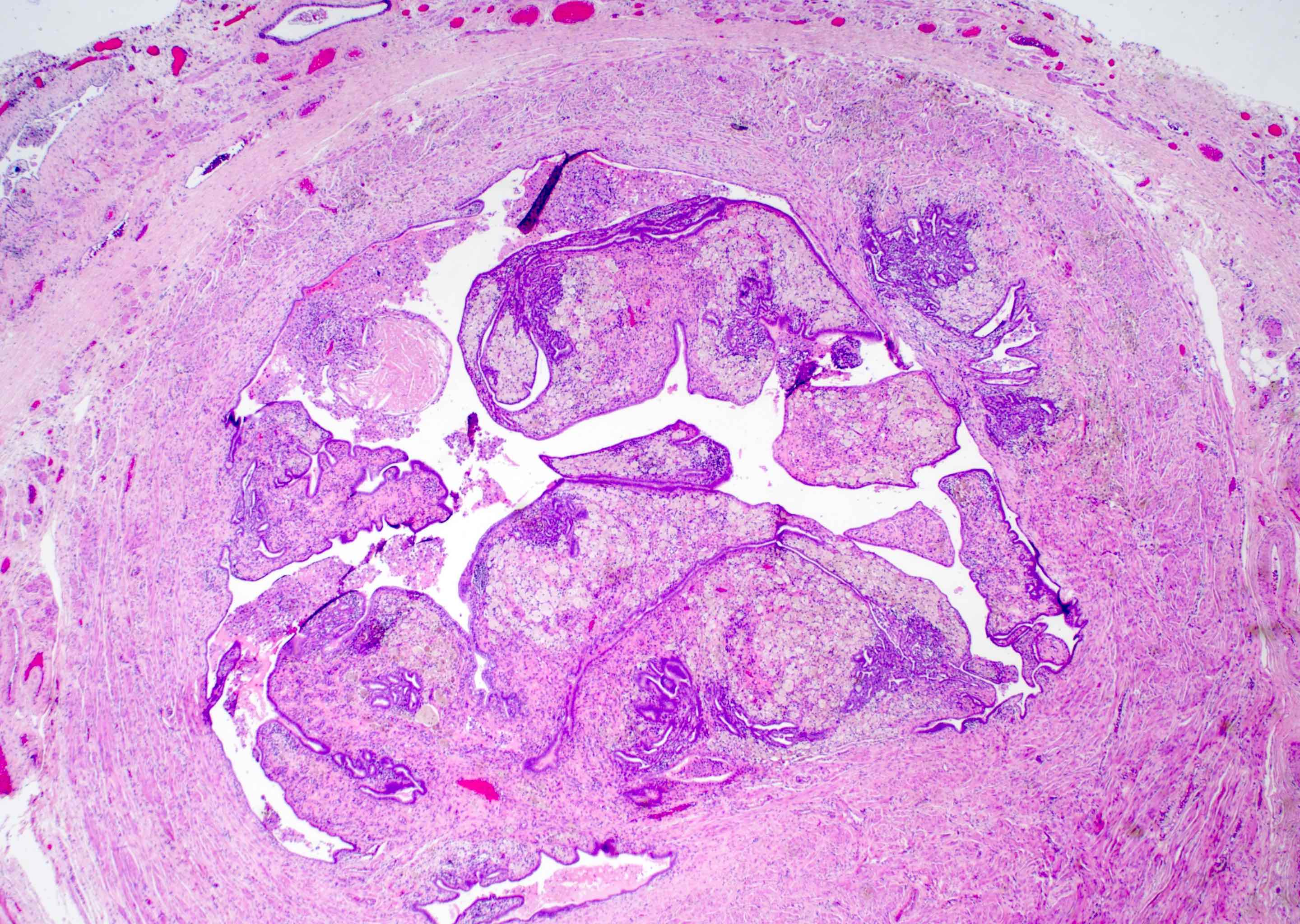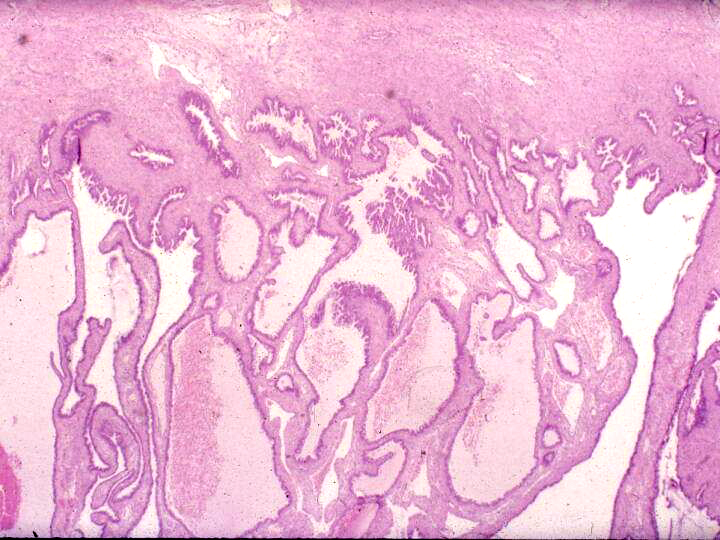Table of Contents
Definition / general | Essential features | Terminology | ICD coding | Epidemiology | Sites | Pathophysiology | Etiology | Diagnosis | Radiology description | Case reports | Treatment | Gross description | Gross images | Microscopic (histologic) description | Microscopic (histologic) images | Sample pathology report | Differential diagnosis | Board review style question #1 | Board review style answer #1 | Board review style question #2 | Board review style answer #2Cite this page: Zarei S. Chronic salpingitis. PathologyOutlines.com website. https://www.pathologyoutlines.com/topic/fallopiantubeschronicsalpingitis.html. Accessed April 1st, 2025.
Definition / general
- Chronic inflammation of fallopian tube with lymphoplasmacytic infiltrate and with or without foamy histiocytes and granulomas
Essential features
- Presence of plasma cells and lymphocytes in the submucosa
- Plicae are fibrotic, fused, short and thick
- May be associated with epithelial hyperplasia
Terminology
- Chronic salpingitis, follicular salpingitis, granulomatous salpingitis, ligneous salpingitis, pseudoxanthomatous salpingitis and xanthomatous salpingitis
Epidemiology
- Women of reproductive age
- Occurs in up to 50% of ectopic pregnancies
Sites
- Fallopian tube, unilateral or bilateral
Pathophysiology
- May be associated with active or prior history of infection (pelvic inflammatory disease) (Fertil Steril 2000;74:152)
- May be seen in association with endometriosis or tubal ectopic pregnancy
- Other associations include inflammatory bowel disease (with pulse granulomas) or other infectious processes (tuberculosis, sarcoidosis) (Int J Gynecol Pathol 2015;34:275)
Etiology
- Several bacterial organisms (Neisseria gonorrhoeae, Chlamydia trachomatis, Mycoplasma), foreign body (lubricants, mineral oil, starch), endometriosis
Diagnosis
- Usually an incidental finding on microscopic examination
- May be associated with pelvic pain, especially in the setting of pelvic inflammatory disease, endometriosis or tubal ectopic pregnancy
Radiology description
- May show hydrosalpinx, unilateral or bilateral
Case reports
- 2 year old girl with xanthogranulomatous inflammation (Case Rep Obstet Gynecol 2015;2015:237250)
- 32 year old woman with bilateral tubal gestation (Case Rep Obstet Gynecol 2014;2014:674514)
- 55 year old woman with tuberculous salpingitis (J Clin Diagn Res 2013;7:1186)
Treatment
- Treating the underlying infection / inflammation if there is concurrent acute salpingitis
Gross description
- Fused fimbriae, causing blunted end (clubbed tube)
- May form significant tubo-ovarian adhesions and a conglomerated mass
- May show marked tubal dilation (hydrosalpinx)
- May show areas of hemorrhage if associated with endometriosis
Microscopic (histologic) description
- Chronic salpingitis (Fertil Steril 2000;74:152):
- Usually short, thick plicae with fibrous stroma, lymphocytes, plasma cells or both in the mucosa
- Hydrosalpinx may or may not be seen
- Plicae may look normal or fused
- Epithelial hyperplasia may be seen
- Granulomas, either necrotizing or nonnecrotizing, suggest infection (especially tuberculosis), sarcoidosis or other autoimmune disease (e.g., inflammatory bowel disease)
- Pseudoxanthomatous salpingitis (Int J Gynecol Pathol 2015;34:275):
- Abundant hemosiderin laden macrophages within fallopian tube lamina propria with associated lymphoplasmacytic infiltrate
- Endometriosis in the tubal subserosa or ovarian tissue
- Xanthogranulomatous salpingitis:
- Foamy histiocytes, granulomas and chronic inflammation in the fallopian tube submucosa (Int J Gynecol Pathol 2002;21:56)
- May be associated with pelvic inflammatory disease
- Follicular salpingitis (misnomer): later stage of chronic salpingitis with fusing plicae, mimicking a pattern of thyroid follicles
Microscopic (histologic) images
Sample pathology report
- Fallopian tube, salpingectomy:
- Chronic salpingitis, xanthogranulomatous salpingitis or pseudoxanthomatous salpingitis
Differential diagnosis
- Fibrotic plica:
- A normal physiologic change in postmenopausal women
- Inflammatory infiltrate is absent
- Physiologic salpingitis during menses:
- Only minimal neutrophilic infiltrate is seen
- Salpingitis isthmica nodosa:
- Nodular thickening of fallopian tube with cystically dilated glands within muscular layer
- No associated inflammation
- Serous tubal intraepithelial carcinoma (STIC):
- Older women
- Cytologic atypia and loss of ciliation
- Abnormal (mutant) pattern of p53 expression by immunohistochemistry
Board review style question #1
Which of the following is the most common finding associated with pseudoxanthomatous salpingitis?
- Endometriosis
- History of prior pelvic surgery
- Inflammatory bowel disease and diverticulosis
- Pelvic tuberculosis
Board review style answer #1
A. Endometriosis. Answer B is incorrect because prior pelvic surgery is not associated with pseudoxanthomatous salpingitis. Answer C is incorrect because inflammatory bowel disease and diverticulosis can be seen in association with pulse granuloma and chronic salpingitis. Answer D is incorrect because pelvic tuberculosis is associated with granulomatous salpingitis.
Comment Here
Reference: Chronic salpingitis
Comment Here
Reference: Chronic salpingitis
Board review style question #2
Which of the following statements is true regarding the photomicrograph above?
- Associated hydrosalpinx is uncommon
- Rarely seen in ectopic tubal pregnancy
- The most common inflammatory infiltrates are neutrophils and eosinophils
- When associated with endometriosis, it has distinct gross and microscopic findings
Board review style answer #2
D. When associated with endometriosis, it has distinct gross and microscopic findings. Answer A is incorrect because hydrosalpinx is common.
Answer B is incorrect because this can be seen in half of ectopic tubal pregnancy. Answer C is incorrect because plasma cells and lymphocytes are usually present in the submucosa.
Comment Here
Reference: Chronic salpingitis
Comment Here
Reference: Chronic salpingitis





